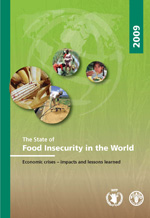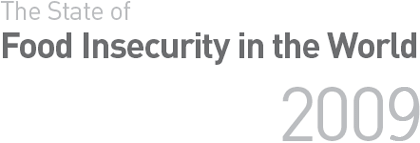



|
|
|

|
 
|
FOOD AND AGRICULTURE ORGANIZATION OF THE UNITED NATIONS
Rome, 2009
Download Full
Report![]() - 2.1Mb
- 2.1Mb

Contents
Key messages
Foreword
Undernourishment around the world
Hunger has been on the rise for the past decade
Case studies of countries affected by the
economic crisis
Armenia
Towards eliminating hunger
The importance of investing in agriculture and public
goods
Technical annex
Table 1:
Notes |
![]()
|
Acknowledgements The State of Food Insecurity in the World 2009 was prepared under the overall leadership of Hafez Ghanem, Assistant Director-General, and the guidance of the management team of the Economic and Social Development Department. The technical coordination of the publication was carried out by David Dawe, who was also the technical editor of the report, Kostas Stamoulis and Keith Wiebe of the Agricultural Development Economics Division (ESA). The staff of the Statistics Division (ESS) generated the underlying data on undernourishment, including the estimates for 2008. This is the first edition of this report that has been jointly prepared by FAO and the World Food Programme (WFP). Valerie Guarnieri, Director of Programme and Design, and David Stevenson, Director of Policy, Planning and Strategy, both from WFP, provided valuable insights and support. Joyce Luma and Arif Husain of WFP served on the Editorial Board. The chapter ퟌ���Undernourishment around the world” was prepared by the Economic and Social Development Department with key technical contributions provided by Gustavo Anriquez, André Croppenstedt, Ali Arslan Gürkan, Mark Smulders and Alberto Zezza (ESA); and Cheng Fang, Kisan Gunjal and Henri Josserand of the Trade and Markets Division (EST). The main text in the section “Quantifying the food security impacts of the economic crisis”, along with the box on “Impact of higher prices on African producers” was contributed by Shahla Shapouri and Stacey Rosen of the Economic Research Service of the United States Department of Agriculture (USDA). Michael Hamp of the International Fund for Agricultural Development (IFAD) contributed the box on microcredit. The chapter on case studies was prepared by WFP under the technical coordination of Joyce Luma. Claudia Ah Poe, Jean-Martin Bauer, Henk-Jan Brinkman, Monica Cadena, Mariana Castillo, Agnes Dhur, Arif Husain, Alima Mahama, Adriana Moreno and Issa Sanogo, all from WFP, contributed the specific country case studies along with Lorena Aguilar of the Famine Early Warning System Network (FEWSNET). The chapter “Towards eliminating hunger” was prepared by the Economic and Social Development Department with key technical contributions from Gustavo Anriquez, Mark McGuire and Julian Thomas (ESA); Ugo Gentilini (WFP) on safety nets and Jean Balié, Barbara Ekwall, and Mauricio Rosales on the right to food. Boxes on Brazil were contributed by Carlos Santana from Embrapa (Brazilian Agricultural Research Corporation) and Flavio Valente, Secretary-General of the FoodFirst Information and Action Network (FIAN). Ricardo Sibrian produced the Technical annex with support from Cinzia Cerri, Seevalingum Ramasawmy and Nathalie Troubat in ESS. Valuable external comments, suggestions and inputs from John Hoddinott (International Food Policy Research Institute [IFPRI]), Richard King (Oxfam GB) and Nancy Mock (Tulane University) were extremely helpful, as were comments from Luca Alinovi (ESA), Lorenzo Giovanni Bellù (Policy Assistance and Resource Mobilization Division) and Marie-Claude Dop (Nutrition and Consumer Protection Division). Adam Barclay made major improvements to the readability of the publication. Anna Antonazzo, Marina Pelaghias, Anne Rutherford and Sandra Stevens provided excellent administrative support, and Aminata Bakouan, Katia Covarrubias, Federica Di Marcantonio, Panagiotis Karfakis, Rafik Mahjoubi and Cristian Morales-Opazo provided invaluable research support. A special thank you is due to the Electronic Publishing Policy and Support Branch of the Knowledge and Communication Department (KC), which provided editorial, language editing, graphic and production services. Translations were provided by the Meeting Programming and Documentation Service of KC. Overall funding was provided under the FAO interdepartmental programme on Food Insecurity and Vulnerability Information and Mapping Systems (FIVIMS). |
![]()
|
Produced by the The designations employed and the presentation of material in this information product do not imply the expression of any opinion whatsoever on the part of the Food and Agriculture Organization of the United Nations (FAO) or of the World Food Programme (WFP) concerning the legal or development status of any country, territory, city or area or of its authorities, or concerning the delimitation of its frontiers or boundaries. The mention of specific companies or products of manufacturers, whether or not these have been patented, does not imply that these have been endorsed or recommended by FAO or WFP in preference to others of a similar nature that are not mentioned. The designations employed and the presentation of material in the maps do not imply the expression of any opinion whatsoever on the part of FAO or WFP concerning the legal or constitutional status of any country, territory or sea area, or concerning the delimitation of frontiers.
All rights reserved. Reproduction and dissemination of
material in this information product for educational or
other non-commercial purposes are authorized without
any prior written permission from the copyright holders
provided the source is fully acknowledged. Reproduction
of material in this information product for resale or
other commercial purposes is prohibited without written
permission of the copyright holders. Applications for
such permission should be addressed to:
© FAO 2009 |
|
Copies of FAO publications can be requested
from: |
E-mail: publications-sales@fao.org |
![]()